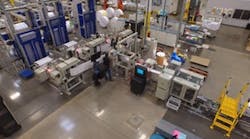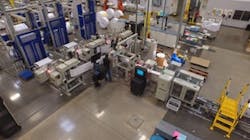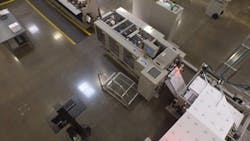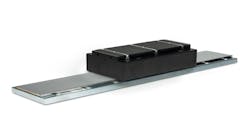Case Study: Variable data finishing system keeps pace with digital-printing technology
Digital-printing technology has made huge gains in recent years, in terms of both speed and flexibility. As a result, manufacturers of printing finishing systems have faced challenges to match that growth with new innovation.
VITS International, a Blauvelt, New York-based global supplier of variable repeat sheeting and finishing systems for the printing, packaging, digital and converting industries, recognized that the digital-printing market needed industrial-strength finishing systems that could deliver the speed, flexibility and ultra-precise registration control to sustain commercial printing production rates. To meet that need, VITS developed the Sprint Variable Data Finishing System, created with a complete, state-of-the-art electric drive and control platform from Bosch Rexroth.
Digital printing drives innovation
Similar to web offset printing, digital inkjet printers are capable of high-speed web-fed output with speeds reaching near-commercial rates of 700 to 1,000 ft/min (FPM). However, digital printing supports variable data printing: it can dynamically vary the content being produced—not just the number of pages for a given product, but variable imaging and significant variations in page dimensions. While this provides new abilities for customization, it vastly complicates how the printed web roll is finished. Finishing systems need to be able to cut, collate and assemble the pages into a final readable piece in the most logical order.
The complexity—high speeds plus variable data printing—was viewed as an important opportunity for VITS. We decided to take a leading role in developing robust, industrial-strength finishing systems that have the technical capacity, speed and sophistication to support both offline and inline finishing with the highest quality.
Sprint System supports in-line and off-line finishing
The Sprint Variable Data Finishing System transforms variable print material to finished product at production rates up to 1,500 FPM. It utilizes patented Clear Channel registration control technology to enable cutting thousands of pages per hour while keeping ultra-precise page registration not previously possible with comparable finishing systems.
“Our printing customers wanted to be able to produce much larger products at much faster rates of speed,” says Kim Markovich, VITS International director of product applications and regional sales and marketing manager. “Particularly for the direct-mail marketplace, being able to finish multiple webs and multiple ribbons and accomplish perfect register control meant that our printing customers could take on more work and be more productive.”
Figure 1: The VITS variable data multi-web finishing system supports two variations: in-line systems, which receive and finish a single web coming directly from the digital printer, and off-line multi-web finishing, which enables the processing of multiple webs into a single finished signature or book
We developed the Sprint system to support two variations: in-line systems, which receive and finish a single web coming directly from the digital printer, and off-line multi-web finishing, which enables the processing of multiple webs into a single finished signature or book (Figure 1).
The team at VITS knew that the controls and drive technology it chose for the Sprint system must have the highest levels of versatility and sophistication—one of the key reasons the team chose Rexroth. “As we looked at the challenges, we came to the conclusion that only Bosch Rexroth would be able to provide the precise control technology we needed,” says John Salamone, director of new product development for VITS.
Ultra-precise multi-web registration control
The Sprint Finishing System consists of modular, independently driven components controlled by a central Rexroth IndraMotion MLC motion control platform. The in-line Sprint system configuration typically has 10 to 12 driven axes, while the more advanced multi-web offline version can have up to 30 driven axes.
Each Sprint module performs specific functions to convert a printed web into a completed book or direct mail piece, and each utilizes a specific set of Rexroth IndraDrive servo drives and proven IndraDyn servo motors.
In the off-line multi-web system, multiple paper rolls are mounted on register splicers that feed the web continuously to the VITS automatic constant-tension infeed. The infeed delivers precise gain/tension control to the web.
The web then passes through an angle bar system that slits it in half and repositions one half over the other, before travelling to a ribbon-gathering station and then over a folder element to fold the ribbons in half.
Figure 2: Once the fold is complete, the web travels through a shear-slitting module where the folded web can be trimmed, and then into the variable data rotary cutter that cuts each page to size and collates/stacks the finished product for the next process, such as final binding or saddle stitching.
Once the fold is complete, the web travels through a shear-slitting module where the folded web can be trimmed, and then into the variable data rotary cutter that cuts each page to size and collates/stacks the finished product for the next process, such as final binding or saddle stitching (Figure 2).
Maintaining absolute registration control of multiple webs, so that every page in every signature is cut to exactly the same dimension, was one of the most significant technical hurdles the team faced.
“Nothing is ever printed perfectly—the length of print can vary by plus or minus ten-thousandths of an inch from page to page,” says Salamone. “That doesn’t sound like much, but after a hundred pages the registration can be off significantly.”
VITS enlisted Bruce Parks of Parks Consulting International (www.parksconsulting.net), a systems integrator with extensive experience using Rexroth printing system controls, to help develop the Sprint automation solution. “The Rexroth drives have a large amount of intelligence built in,” says Parks. “So we use the drives to maintain registration on the web in a dynamic fashion, which then frees up the processing power of the central IndraMotion MLC controller.”
All drives maintain synchronization with a virtual master. Tension zones are created between individual drives in each module to maintain optimal tension when variations occur as webs merge, split and are cut. Groups of drives are also created, allowing adjustments to be made as a group to bring the web into proper register with the virtual master.
The team used the industry-specific IndraMotion for Printing version of Rexroth’s IndraMotion MLC system as the automation platform, featuring IEC 61131-compliant motion-logic controls and PLCopen function blocks along with extensive software libraries for printing and converting functions.
“IndraMotion for Printing provides engineering tools that work right out of the box to accomplish most of the web handling tasks,” says Parks. “We then used Rexroth’s PLCopen function blocks as the starting point to build the special camming profiles and functions we needed for the proprietary VITS Clear Channel registration capability.”
Rotary cutting chip control
The other major challenge for the Sprint team was having a rotary cutter that could handle variable data—infinitely variable image sizes ranging from 5 to 25 inches—and be configured to cut different-width chips—the blank space between pages on the web roll—all with the push of a button, rather than a time-consuming changeover.
In the rotary-cutter module, two knives cut the chip out; the knives are separated by the width of the chip, and the cutting needs to be synchronized with the speed of the web through the system. “Our camming process allows us to cut variable-size products with multiple knives and still maintain chip size because we always synchronize with the web speed through the cutting zone,” Salamone says.
The Clear Channel register control provides faster size changes, as well as cut tolerances never before provided by standard finishing systems, which is a competitive advantage for both VITS International and its customers that choose the system.
Collaboration chemistry
This is the first system we’ve produced using a complete Bosch Rexroth drive and control platform—a decision that was made after a thorough evaluation.
We had a great relationship with our previous supplier who was a close business partner and was always there to work through any issues. With Bosch Rexroth, we found similar values and commitment. More importantly, it was the technology that allowed us to develop our equipment much faster, with world-class accuracy that none of our competitors have. We now have Rexroth-equipped machines located all around the world. Their performance and reliability is good; they are working flawlessly.
It has turned out to be the best decision for our growth and our future to work with Rexroth. We could not imagine doing what we are doing now without their technology and their capabilities. With a lot of input from our team and the right technology, we were able to solve the challenges we encountered. It took all three partners—Bosch Rexroth, VITS International and Parks Consulting International—to go from ideas to working solutions.

Leaders relevant to this article:






